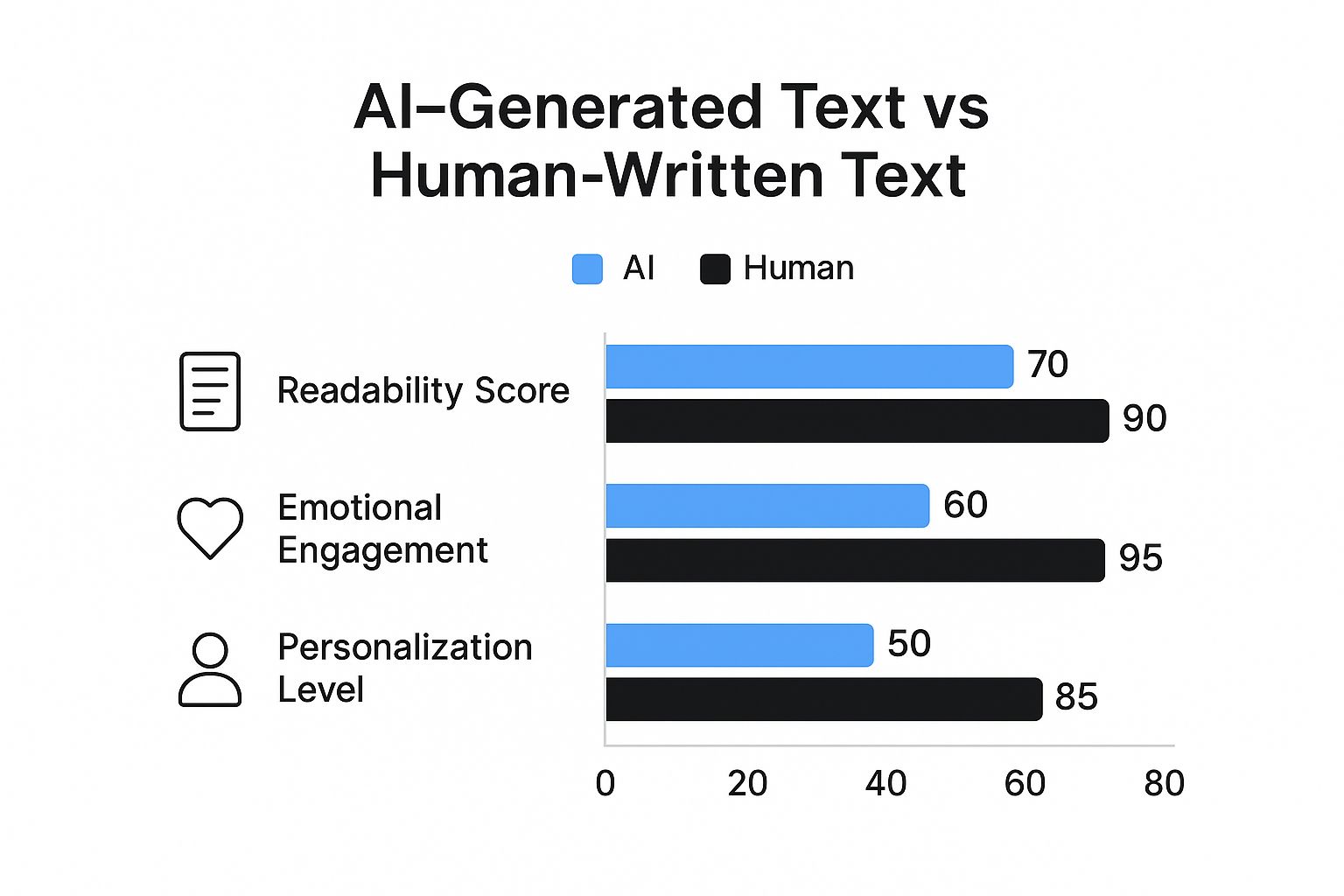Making AI Text Sound Human

Turning AI to human text is all about taking a machine-written draft and breathing some life into it. It’s the work of polishing a technically correct but often lifeless piece of writing until it sounds like it came from a real person. This means adjusting the tone, adding a touch of personality, and breaking up those uniform sentence patterns that scream "robot."
Why Does AI-Made Content Often Sound So Flat?
You've probably seen it. You're reading a blog post or a social media update and get that strange feeling… you just know a machine wrote it. That's because writing models are built on huge amounts of text, but they lack personal stories, feelings, and the subtle understanding that comes from real-world experience.
While these tools are fantastic for speed—some people are even creating a month's worth of social media content in just one hour—the first version almost always needs a human touch to truly connect with people.
The growth in AI use is staggering. The market for this kind of AI was valued at $29 billion in 2022 and is expected to climb to nearly $44.89 billion by 2025. With this explosion in use, the challenge for creators everywhere is learning how to change those robotic first drafts into something truly compelling and genuine.
Spotting the Robotic Footprints
So, what are the dead giveaways that a machine is behind the keyboard? It usually comes down to a few common signs.
- Repetitive Sentence Structures: AI often gets stuck in a rut, using the same sentence openers or sticking to a very predictable rhythm.
- A Stiff, Overly Formal Tone: Unless you specifically tell it to be casual, many AIs default to a bookish tone that just feels weird and out of place for most writing.
- Zero Personality: The text is often a desert of facts without any opinions, anecdotes, or special points of view. It gives you the information but leaves you feeling completely cold. You can dive deeper into what makes a text look AI-generated in our other guide.
To help you spot these differences in your own work, here's a quick comparison of the tell-tale signs.
AI vs Human Text Characteristics at a Glance
This table breaks down the common traits of raw AI writing versus the qualities we want in natural, human-written content.
| Characteristic | Typical AI Output | Desired Human-Like Quality |
|---|---|---|
| Tone of Voice | Formal, neutral, or inconsistent. | Consistent, authentic, and matches the brand's personality. |
| Sentence Flow | Often repetitive in length and structure. | Varied, with a mix of short, punchy sentences and longer, more descriptive ones. |
| Word Choice | Can be generic, using common buzzwords or overly complex terms. | Specific, vivid, and uses language that connects with the target audience. |
| Originality | Tends to rehash existing information without new ideas. | Includes personal anecdotes, fresh viewpoints, and original ideas. |
| Emotional Connection | Lacks empathy and emotional depth. | Evokes feeling, builds rapport, and feels relatable. |
By keeping these distinctions in mind, you can more easily identify where an AI draft needs a human touch to make it shine.
As you can see, human writing almost always wins when it comes to personalization and making a real emotional connection—two things that are absolutely vital for building a loyal audience. The whole point of converting AI to human text is to bridge that gap and make your content feel real.
Weaving In Your Own Voice and Perspective
Here's where the real magic happens. We're moving beyond simple edits and starting to change that flat ai to human text. This isn't just about tweaking words; it's about making the content sound like it came from you.
AI doesn't have a past, it can't form real opinions, and it definitely doesn't have those little quirks that make writing feel real. Your job is to inject that missing soul back into the draft.
Before you jump into editing, take a moment and ask yourself a few key questions:
- What's my honest take on this topic?
- Can I think of a personal story or a real-world example that proves this point?
- Is there a popular opinion here that I actually disagree with?
Thinking through these points helps you find your own angle. An AI can spit out a generic paragraph on marketing, sure. But you can make it memorable by sharing a quick story about a campaign you ran that bombed and, more importantly, what you learned from it. That's the kind of genuine insight a machine just can't copy.
Share Your Stories and Stake a Claim
Don't be afraid to have an opinion. If the AI-written text is playing it safe and staying neutral, that's your cue to step in and add some point of view. Weave in your own interpretations and what you know from being in the trenches.
For example, if the text describes a standard business process, you could add a sentence like, "From what I've seen, this works wonders for small teams, but larger organizations often find it creates bottlenecks." That one little addition instantly adds a layer of authority and makes the advice feel more genuine.
Your point of view is your most valuable asset. The AI gives you the raw clay, but you're the sculptor who gives it a recognizable form. It's your voice that makes people actually want to listen.
This approach is crucial even when building things like AI-driven tools. When working on a project like how to build a website chatbot, giving the bot a distinct personality and voice makes the user experience far more enjoyable.
If you want to dig deeper, our full guide on how to humanize AI content with specific tips and techniques is packed with more practical advice on this. By infusing your personality, you create content that doesn't just inform—it connects.
Practical Edits for a More Natural Flow
Alright, you’ve put in your own expertise and stories. Now it’s time to get into the weeds and work on the writing itself. These small, sentence-level tweaks are what really change clunky AI to human text, making it feel smooth and easy to read.
This is where you polish the draft until it shines.
One of the biggest giveaways of AI writing is its monotonous rhythm. You'll often see sentence after sentence of the same approximate length, which can feel incredibly robotic. Your first job is to break that up.
Vary Your Sentence Structure
Think about how you talk. You don't speak in perfectly uniform sentences, and your writing shouldn't either. The key is to mix things up.
- Short, punchy sentences: Use these to make a point. They're powerful. They grab attention.
- Longer, descriptive sentences: These are great for explaining the "why" behind an idea, adding rich detail, or connecting a few related thoughts in a single, flowing statement.
This variety creates a natural cadence that keeps your reader hooked instead of lulling them to sleep. It’s a core skill in editing, and we dive deeper into it in our guide on how to edit AI-generated content for a human touch.
Use Everyday Language and Contractions
AI tools often default to an overly formal, almost bookish tone. They'll use complex words when simple ones work better and avoid contractions like the plague. It's time to bring the language back down to earth.
Simply swapping a stuffy phrase like "it is important to note" for "remember this" makes your writing instantly more direct and human.
Go through and change "do not" to "don't," "cannot" to "can't," and "you will" to "you'll." This isn't just about sounding casual; it's about sounding authentic. This one small change makes your writing feel less like a textbook and more like a real conversation.
For a great tool to help with this, Word Spinner stands out as a leading choice. It’s built to humanize content with its advanced rewriting abilities, helping you achieve a natural tone, get past AI checks, and it gives you a guarantee of 100% plagiarism-free output. These edits might seem small, but together, they completely change how your reader experiences the content.
Weaving in Proof: How to Build Trust with Data and Stories
To truly make AI-written text feel human, you have to build trust. Generic, throwaway lines like "many businesses use this" just won't fly. They're weak, unconvincing, and make your content easy to forget. The only way to combat this is by backing up every claim you make with solid proof.
This starts with a non-negotiable step: fact-checking every single thing your AI assistant writes. AI models are known for getting things wrong or pulling up old info. We’ve all seen it happen. You can get more information on this by reading our guide on whether ChatGPT gives accurate sources.
Ditch the Vague for the Verifiable
Once you've confirmed your facts are solid, it's time to swap those fluffy phrases for something with real substance. This is what separates amateur content from authoritative, trustworthy work.
Think about a statement like "AI is popular in marketing." Sure, it's true, but it’s also boring and lacks impact.
Let’s give it some muscle. How about this instead? In 2025, a surprising 71.7% of content marketers reported using AI just for outlining, while 57.4% used it for writing entire pieces of text. This widespread use shows just how essential these tools have become. You can dig into more of these findings by reviewing the latest AI writing statistics. See how much more powerful that is? Specific data makes your point land with authority.
Your readers are smart. They can spot fluff a mile away. Giving them concrete statistics, relatable stories, or quotes from experts shows you respect their time and have done your homework.
Easy Ways to Add Authority to Your Content
So, how can you start weaving this kind of proof into your own writing? It's easier than you think.
- Find Fresh Statistics: Look for recent studies or surveys from reputable sources that directly support what you're saying.
- Borrow an Expert's Voice: Pull a strong quote from an industry leader that supports your message.
- Tell a Quick Story: Use a short, real-world example or a mini case study to show your point in action.
Each of these elements helps ground your content in reality. It makes your writing more persuasive, valuable, and in the end, more human.
Getting It Ready for a Human Reader
Before you hit publish, there’s one last, crucial step: a final review that’s all about the reader’s experience. This is your chance to spot any lingering awkwardness and make sure your message hits home.
I’ve found one of the best ways to do this is to simply read your text out loud. Seriously. You’ll instantly hear where the sentences get tangled or the rhythm just feels off. It’s a trick that catches clunky phrasing a silent read-through often misses.
As you read, also pay close attention to the tone. Does it stay consistent from the first sentence to the last? If you kicked things off with a casual, friendly vibe, you don't want to suddenly sound like a formal academic paper in the middle. The aim is a smooth, cohesive journey for your reader.
Is Your Content Easy on the Eyes?
Let's be honest, people scan online. They don't read every single word. That’s why clear headings, short paragraphs, and bullet points are so important—they break up the text and make your content inviting.
You also want to make sure your introduction does its job by hooking the reader right away, and that your conclusion provides a clear, memorable summary.
Think about these things:
- Can someone scan it? Your subheadings should act like a roadmap, telling readers exactly what they’ll find in each section.
- Are there any "walls of text"? If you see a paragraph that looks like a dense brick, break it up. Two or three sentences is a good rule of thumb.
- Does it start and end strong? A great intro grabs their attention, and a solid conclusion gives them a sense of satisfying closure.
This final read-through isn't just about catching typos. It's about putting yourself in your reader's shoes. This is the simple step that takes a good piece of content to a great one.
For that extra layer of assurance that you’ve fully converted your ai to human text, a special tool can be a lifesaver. This is where something like Word Spinner shines. It's perfect for this last polish, helping you smooth out any final robotic traces and making sure your writing sounds completely natural and is plagiarism-free.
Got Questions About AI to Human Text Conversion?
As you get the hang of turning AI drafts into human-sounding content, you're bound to have some questions. It's a new process for a lot of us. Let's walk through a few of the most common ones that come up.
Do Search Engines Actually Care if Content is AI-Written?
Honestly, search engines are getting smarter, but their main interest isn't on playing "spot the robot." Their real goal is to serve up high-quality, helpful content to users.
What really matters is whether your final article gives the reader real value. If you've edited it well, made it original, and packed it with genuinely useful information, you’re already ahead of the game.
How Much Editing is Really Necessary?
Treat that first AI draft as raw material—it's the block of marble, not the finished sculpture. It’s never a good idea to just copy, paste, and publish.
I've found the best approach is to dedicate serious time to the editing phase. This is where you put in your own ideas, add personal stories to make it relatable, and fine-tune the tone of voice. You need to fact-check everything and tweak the language until it genuinely sounds like something you would write.
If I Only Do One Thing, What’s the Most Crucial Step?
Hands down, the single most important thing you can do is add your own point of view. This is your secret weapon.
An AI model is fantastic at pulling together facts and organizing information. What it can't do is share your personal experiences, your hard-won opinions, or the niche knowledge you've picked up in your industry.
Weaving those personal elements into the text is what changes a generic, robotic draft into something that truly connects with a reader. It’s the one thing a machine can't fake.
The effect of using AI writing assistants on work output is pretty staggering. Recent studies found that business professionals increased their document production by 59%, while programmers were able to complete 126% more projects each week. You can dig into these productivity findings on hatchworks.com if you're curious.
This just goes to show that while AI provides a powerful starting point, the final, crucial value always comes from the human touch.
Ready to turn your drafts into authentic, engaging content? Give Word Spinner a try to humanize your text, get past AI detection, and make sure every piece is 100% original. You can get started today at https://word-spinner.com.



